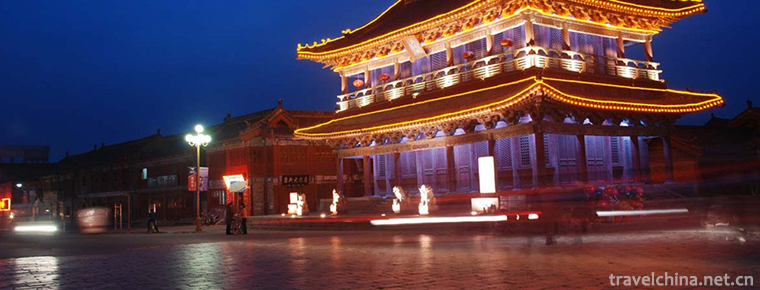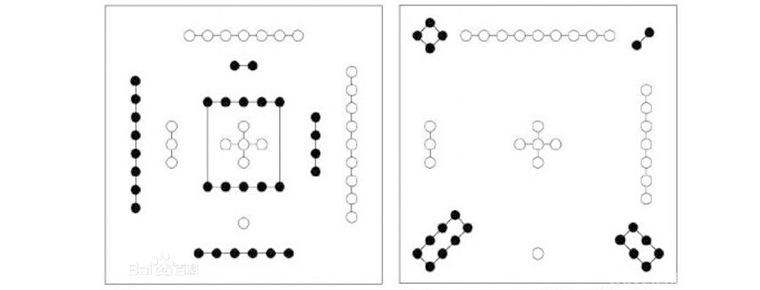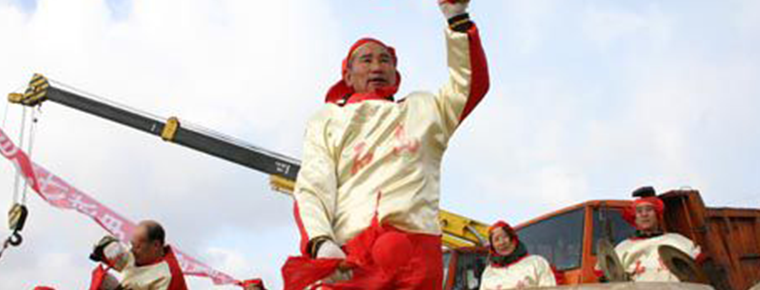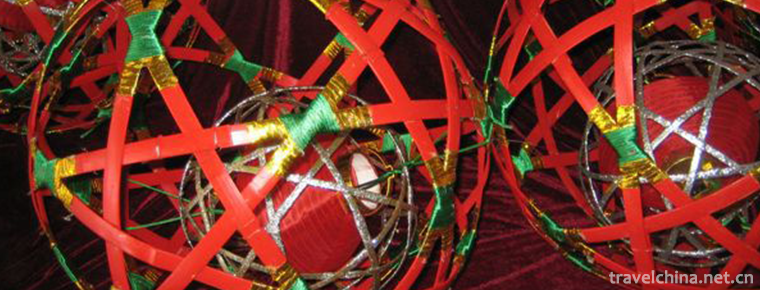Zhanqiao
Zhanqiao
Qingdao Trestle Bridge is one of the scenic spots of Qingdao Seaside Scenic Spot. It is the first national scenic spot announced by the State Council in 1982, and also the first national AAAA-level scenic spot .
Qingdao Trestle Bridge is located at the southern end of Zhongshan Road in Qingdao, which is crowded with tourists. Its body penetrates into the deep of Qingdao Bay like a crescent from the coast. The bridge body is for visitors to visit and berth the tourist boat here, so you can see Qingdao at sea by boat.
Qingdao Trestle Bridge was built in 1892 in Guangxu of Qing Dynasty. It is the earliest military artificial wharf building in Qingdao. It is now an important landmark building and a famous scenic spot in Qingdao .
Qingdao trestle is 440 meters long, 8 meters wide and steel-concrete structure. At the south end of the bridge, a semi-circular breakwater is built with two-storey octagonal buildings in the form of ethnic groups, named Huilan Pavilion. Visitors stand beside the pavilion and appreciate the huge waves coming from different layers. The flying Pavilion is known as one of the ten sceneries of Qingdao. Along the north coast of the bridge, it is called "trestle park". Flowers and trees in the park are sparse, green pine and green grass, and there are stone chairs for visitors to sit and enjoy the sea scenery
geographical environment
Qingdao is located in the north temperate monsoon region, which belongs to the temperate monsoon climate. Because of the direct regulation of the marine environment, the urban area is influenced by the Southeast monsoon, current and water mass from the ocean surface, so it has obvious marine climate characteristics. The air is humid, the temperature is moderate and the seasons are distinct. In spring, the temperature rises slowly, one month later than inland; in summer, it is hot and humid, but there is no hot summer; in autumn, it is high and cool, with less precipitation; in winter, the monsoon is high and low, and lasts for a long time, but there is no severe cold.
Qingdao is located on the coast of the Yellow Sea. It is obviously affected by the ocean climate. The annual average temperature is 12.3 C, and the hot weather whose daily average temperature is higher than 30 C seldom occurs. Therefore, there is no hot summer in Qingdao. But the winter duration of Qingdao is longer, the temperature is lower, often accompanied by strong winds, and the average temperature is - 0.9 C.
Main attractions
Huilan Pavilion
Huilange Pavilion is located on the seashore of the Southern District of Qingdao City, facing Xiaoqingdao with water barrier. Its northern end is connected with Zhongshan Road in a straight line. It is regarded as an important symbol of Qingdao. This Pavilion is a two-storey octagonal pavilion, covered by colored glazed tiles, supported by 24 red lacquer pillars, with spiral staircases in the center of the pavilion, and glass windows around the upstairs. It has the saying of "one window, one scene, one painting". We can look through the window and see the beautiful Qingdao Bay, the surrounding scenic spots and the famous buildings in an all-round way.
In 1930, Shen Honglie, the mayor of Qingdao at that time, decided to carry out a comprehensive transformation of the trestle which had become an important tourist attraction in Qingdao.
Construction began in September 1931, and a semi-circular breakwater was built at the southern end of the bridge. On the breakwater, a double-layer octagonal pavilion with traditional Chinese style was built, named Huilan Pavilion. The top of the pavilion is covered with yellow glazed tiles, with 24 round Pavilion columns around it. The cabinet is a two-storey spherical hall with 34 spiral steps in the center, which can be swirled up to the second floor. In April 1933, the whole project was completed.
The three words on the plaque of Huilan Pavilion in Feige were initially inscribed by Shen Honglie, the former mayor of Qingdao. The plaque was plundered to Japan during the second Japanese occupation of Qingdao. After the founding of New China, many people went to Japan to look for the plaque, but they could not find it. At present, "Huilange Pavilion" is written by Shu Tong, a famous calligrapher.
In 1936, among the "Ten Sceneries of Qingdao" selected by the Municipal Government together with experts and citizens, the "Flying Pavilion Return" with trestle as the main scene became the first one. On January 16, 1992, the Qingdao Municipal People's Government announced that it was a key cultural relic protection unit at the municipal level.
zhongshan road
The road along the North-South straight line of the same trestle is Zhongshan Road. It is an old commercial street in Qingdao City. It has a history of more than 100 years. After the German occupation of Qingdao, in order to build a deepwater Wharf in the back sea, a north-south connection road was opened in 1899, which is the prototype of Zhongshan Road. To the south of Dexian Road is a German residential area, named "Fidelity Street", and to the north of Dexian Road is a Chinese residential area, known as the Big Road. In 1922, the two roads merged and named Shandong Road. In 1929, in memory of Dr. Sun Yat-sen, it was renamed Zhongshan Road. Zhongshan Road is 1300 meters long, 63 buildings and more than 160 shopping malls. At the same time, it is also one of the 100 national demonstration sites of civilization established by the state.
At present, Zhongshan Road is also one of the most prosperous places in the old urban area. In this way, the trestle has become the transition between the sea and the market. It connects the sea and land closely. The tallest building on Zhongshan Road is Baisheng Commercial Building, which opened in September 1998. It is one of the first 18 joint venture retail enterprises approved by the State Council. It is jointly constructed by Qingdao First Department Store Company and Malaysian Golden Lion Group. Its total investment is 780 million yuan. It has five floors underground and 49 floors above ground. Its building area is 120,000 square meters and its shopping mall area is 50,000 square meters. At that time, it was called the first floor of Qilu commerce.
Little Qingdao
The Island opposite Huilange Pavilion is Xiaoqingdao. Xiaoqingdao is located in Qingdao Bay on the north side of Jiaozhou Bay estuary, with beautiful scenery. The original name of the island is Qingdao. The island was named Qingdao because of its lush forests all the year round. There is Huangdao on the opposite side. Qingdao was built in 1929. It was also named after the island at that time. It is 720 meters away from the coast, only 17.2 meters above sea level, and has an area of only 0.012 square kilometers.
In the 16th year of Qianlong (1751) of Qing Dynasty, Lingshan Wei Zhi recorded: "Xiaoqingdao is on the other side of Huaizi Port, the only way for those who enter the sea". Because the island is like a guqin, the water is like a string, and the wind blows Boeing like the sound of a piano, it is also known as the "qin island". Every summer, the sea breeze blows, the trees are lush, and it has the reputation of "Qingang Cuidi Drops". The island's "Qin Nv" sculpture is also one of the symbols of Qingdao.
When Germany occupied Qingdao, Xiaoqingdao was named "Akana Island". After Japan replaced Germany in occupying Qingdao in 1914, the island was changed to "Kato Island". After Qingdao's return, the Jiao'ao Governor's Office named it Xiaoqingdao and opened it as "Xiaoqingdao Park" in the early 1930s. It has tea halls, flower beds, stone benches, stone chairs, roads, yacht terminals, and tourists can go by boat. After the second Japanese occupation of Qingdao, it became a Japanese Garrison and has been used for military purposes ever since. In 1942, a 377-metre-long and 8-metre-wide dyke was built to connect the land to form a continental island.
There is a white lighthouse at the top of Xiaoqingdao. It was built by Germans in 1900. It is a key protected cultural relic in Qingdao. It is 15.5 meters high and octagonal. It is equipped with a mirror with crystal prism. It shines with a bull-eye rotating flashlight. It was replaced by a Spanish-made beacon lamp in 1997. The original lamp was sent to the collection of Qinhuangdao Airmark Museum. The lighthouse has a sea range of 15 nautical miles and is an important navigation mark for ships passing through Jiaozhou Bay. Along with the trestle, it is regarded as the main symbol of Qingdao. There are "a red light in the vast bay, when the sun is shining, the White Pagoda of Cui Dao is bathed in the night, and the lantern of Qinyu is famous." It is said.
In the summer of 1988, Xiaoqingdao was rebuilt as a tourist attraction in Qianhai. Nowadays in Xiaoqingdao, black pine, cherry blossom, green peach, pomegranate, hibiscus, crape myrtle and other flowers and trees are planted everywhere .
Bathing Beach
The beach on the west side of the trestle is the sixth bathing beach. It is the smallest bathing beach in the city. It is adjacent to the bustling Zhongshan Road and has a beautiful surroundings. It can accommodate thousands of tourists to play at the same time. The sand is fine and soft, especially suitable for playing on the beach. Sixth, the beach is not far from Xiaoqingdao. Every night, the navigational lights and shadows on Qindao Island and the beach waves shine together, forming a fascinating night scene.
Customs building
Established in October 1992, the Customs Building has 26 floors, 24 floors above ground and 2 floors below ground. It is 139.9 meters high. Although named after Qingdao, Qingdao Customs is the general administrative organ of Shandong Port's entry and exit supervision. It has more than ten customs offices, including Jinan, Zibo, Weifang, Yantai and Weihai, under its jurisdiction. It is one of the three major customs offices in northern China and has been Supervising Import and export cargo for five consecutive years since 1997. It ranks first in the country.
Sea Palace
The Maritime Palace is a tourist attraction which integrates sightseeing, entertainment, performance and catering. It invests more than 100 million RMB. The whole building is composed of a few quarter of the circles. It has six floors, one floor underground and five floors above ground. It is supported by 108 pillars and has a building area of 11,000 square meters. It is classified as the first-class restaurant in Qingdao with first-class environment and five-star service.
Zhanqiao Hotel
East of the trestle and north of Taiping Road, there is a trestle hotel. It was originally the hotel department attached to Qingdao Hotel in Germany. It was designed by German architect Paul Friedrich. It is a typical German classical architecture. The main building of the former German Grand Hotel was demolished in 1993.
During the German occupation of Qingdao, the younger brother of the German Emperor William II, Prince Heinrich, visited Qingdao many times and stayed in this hotel, which was then commonly known as "Prince Henry Hotel" or "Prince Henry Hotel". Sheng Xuanhuai, then the German Prince of Merkelenburg and Minister of post of the Qing Dynasty, also lived here. In August 1922, Sun Yat-sen went to Beijing to meet with Yuan Shikai. On his way back to Shanghai, he arrived in Qingdao under German rule on September 28 and stayed at this hotel.
Practical information
Ticket information
Qingdao trestle has been an open management for a long time. After April 1, 2000, the closed management of tourists'fees was implemented. From March 5, 2003, Qingdao Trestle was reopened free of charge .
Safety tips
There are many tourists on the trestle on weekdays, especially on various holidays. When walking near the trestle, we should pay attention to safety and keep our belongings well.
Opening Hours
The peak season is 07:00-19:00; the off season is 08:00-17:30.
Traffic information
Ride 2, 5, 6, 8, 25, 26, 217, 220, 223, 225, 301, 304, 305, 307, 308, 311, 312, 316, 320, 321, 325, 412, 501, tunnel 2, Tunnel 3 and tunnel 6.
Take Metro Line M3 and get off at Qingdao Station.











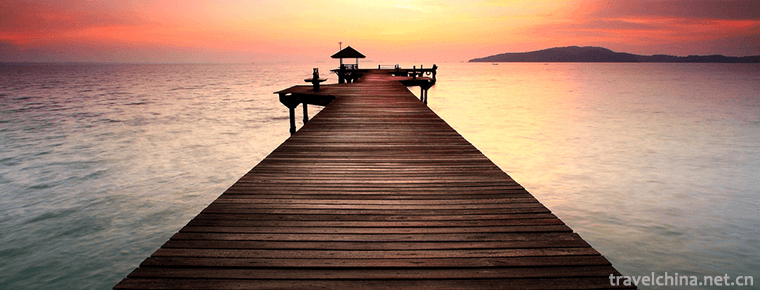
-
Tiananmen Square
East Chang'an Avenue, Dongcheng District, Beijing, China.
Views: 316 Time 2018-10-02 -
The Huaming Tower Scenic Area
Huaming Tower Tourist Area: National AAAAA Tourist Area, National Key Cultural Relics Protection Unit, National Patriotic Education Base..
Views: 169 Time 2018-12-12 -
Lion Tower Tourist Area
Lion Tower Tourist City is located at the head of the cross street of Yanggu County Town. It was built in Jingyou of the Northern Song Dynasty for three years..
Views: 100 Time 2019-02-08 -
Bay Leaf Jing Making Skills
In June 2008, the technique of making bay leaf Scriptures was listed in the national intangible cultural heritage protection list. The Beiye Sutra (Dai for "lazy") refers to the Buddhist.
Views: 133 Time 2019-04-04 -
Legend of Hetuluo Books
The legend of Hetu Luoshu is a folklore system about Hetu and Luoshu, which was born in Luoyang, Henan Province. It mainly includes the legend of Longma Negative Tu Temple and the offering of Luoshu b.
Views: 173 Time 2019-05-03 -
Hu Qingyutangs Traditional Chinese Medicine Culture
Hu Qingyutang's traditional Chinese medicine culture is one of the national intangible cultural heritages and the traditional trade customs preserved by Hu Qingyutang..
Views: 142 Time 2019-05-03 -
Jiaodong drum
Jiaodong Drum is a folk folk folk art form which originated in the coastal counties of Jiaodong Peninsula. It has a history of more than 260 years so far. It originated from the blind.
Views: 316 Time 2019-05-06 -
Traditional Processing Techniques of Liuweizhai Sauced Meat
Liuweizhai is a well-known Chinese brand which was founded in 1738 in the three years of Qianlong in Qing Dynasty. Its sauced meat, as a traditional food in China and a famous food in the Three Jin Dy.
Views: 142 Time 2019-05-14 -
Yuhang Rolling Lamp
Yuhang Rolling Lamp is a kind of Han folk dance which combines athletics, martial arts and dance. It is made of bamboo pieces of large sphere as the main props, in the center of the sphere of bamboo k.
Views: 148 Time 2019-07-14 -
Former residence of Wu Yuzhang
Wu Yuzhang's former residence is located in group 6, caijiayan village, Shuangshi Town, Rong County, Zigong City, Sichuan Province. It is 14km away from the county seat and 32km away from Zigong City..
Views: 167 Time 2020-10-15 -
Deyang Education
By the end of 2018, Deyang had 856 schools, with 33000 full-time teachers and 543000 students. Among them, 339 primary schools enroll 32000 students and 185000 students; 123 junior high schools, 28000 students and 80000 students; 23 senior high schools.
Views: 333 Time 2020-12-14 -
Meishan administrative division
Meishan City has 6 county-level administrative divisions (Municipal District 2, county 4), and 80 township level administrative divisions (street 13, town 62, township 5). It covers an area of 7134 square kilometers and has a population of 3.5 million. Meishan Municipal People's Government in Dongpo District Meizhou Avenue West Section 2..
Views: 325 Time 2020-12-18


